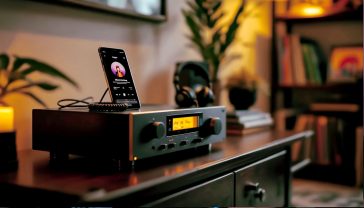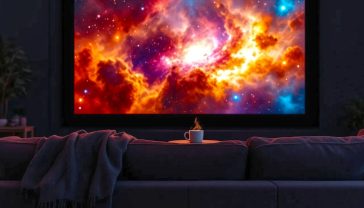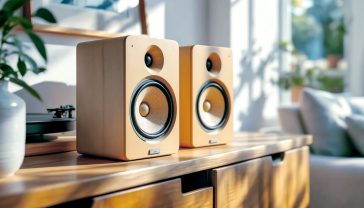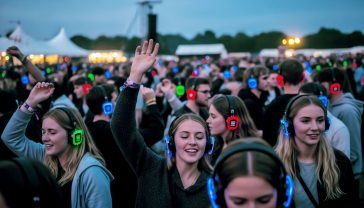Quantum Music: Listening to the Universe’s Secret Playlist
Explore quantum music, a mind-bending genre where composers use the strange rules of physics—superposition and entanglement—to create otherworldly soundscapes.
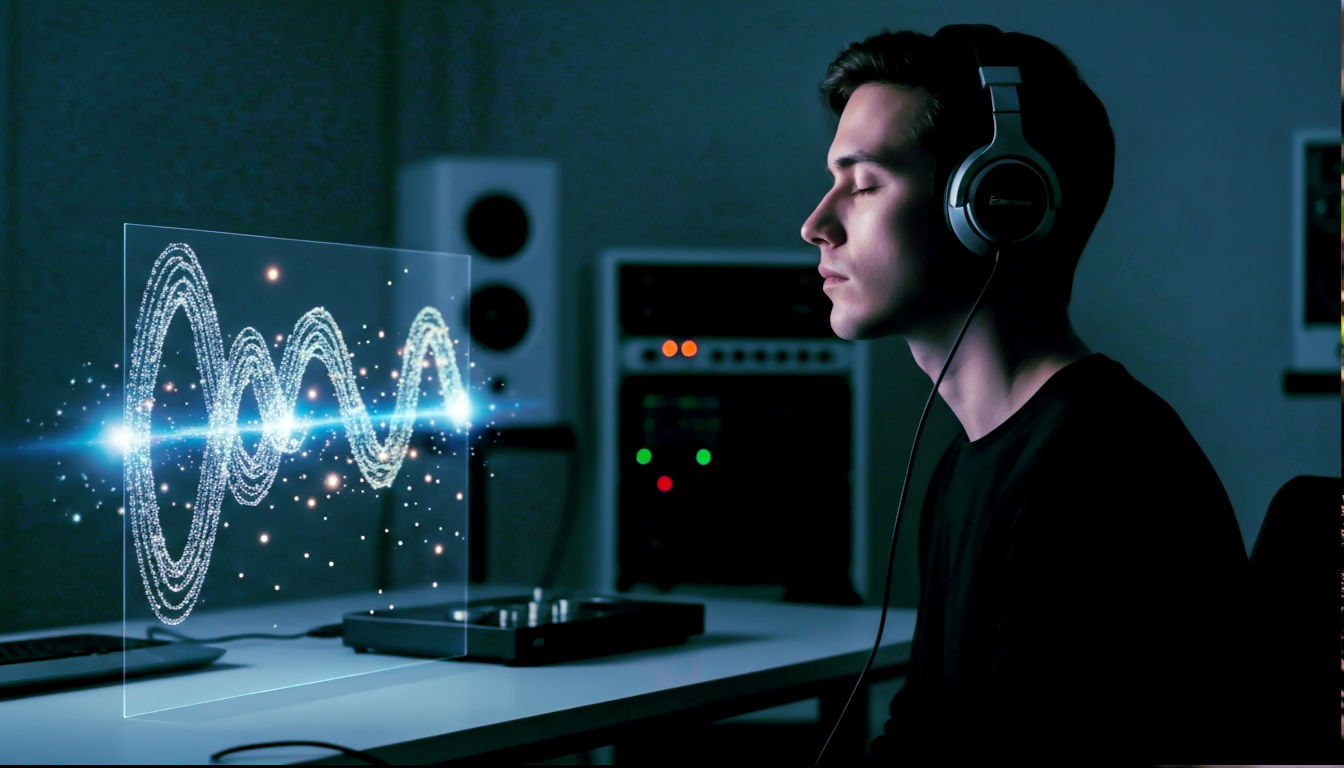
This post may contain affiliate links. If you make a purchase through these links, we may earn a commission at no additional cost to you.
What if you could listen to the building blocks of reality? Not just the sounds of the world around us—the birdsong, the traffic, the hum of a fridge—but the secret, fizzing, unpredictable music made by atoms themselves. Imagine a melody not written by a human, but dictated by the strange and wonderful rules of the quantum world, where particles can be in two places at once and mysteriously linked across vast distances.
This isn’t science fiction. It’s quantum music, a mind-bending new frontier where scientists, musicians, and artists are plugging their instruments directly into the fabric of the universe. It’s a genre that asks a profound question: if all of life is a dance of tiny, strange particles, what does that dance sound like?
For most of us, the word “quantum” brings to mind brain-melting physics, chalkboards full of equations, and Schrödinger’s famously uncertain cat. It feels a million miles away from the visceral, emotional punch of our favourite song. But what if the two are more connected than we think? What if this new way of making sound isn’t just a clever gimmick, but a genuine glimpse into the future of art, science, and maybe even what it means to be creative?
Get ready to explore a world where the weirdness of quantum mechanics is being transformed into breathtaking soundscapes. It’s a journey that will change the way you think about music, reality, and the hidden harmonies humming just beneath the surface of our world.
First, a Quick Trip into the Quantum Realm (Don’t Worry, It’s Painless)
Before we can understand the music, we need to get our heads around the basic ideas of the science behind it. Quantum mechanics is the rulebook for how things work on the tiniest scales—for atoms, electrons, and all the other bits and bobs that make up everything. And let’s be honest, the rules are bonkers.
Forget the predictable, common-sense world of footballs and snooker balls. Down here, things get weird. Here are the key ideas that composers are using to make music.
Superposition: The ‘Maybe’ State
In our everyday world, things are one thing or another. A light switch is either on or off. A coin has landed on either heads or tails. Simple. But in the quantum world, a particle can be in a state of superposition, meaning it’s in multiple states at once.
- Simplified Explanation: Imagine a spinning coin before it lands. For that brief moment it’s both heads and tails. A quantum bit, or qubit—the basic building block of a quantum computer—is just like that. It can be a 0, a 1, or both at the same time. It only ‘chooses’ a state when we measure it.
- Detailed Explanation: Superposition is a fundamental principle where a quantum system, like an electron, exists in a combination of all its possible states simultaneously. This is described by a mathematical object called a wave function. The act of measuring the system causes this wave function to “collapse,” forcing the particle into a single, definite state. For a qubit, its state can be represented as a point on the surface of a sphere (known as a Bloch sphere), allowing for an infinite number of possible superposition states between the poles of 0 and 1.
For a musician, this is incredibly exciting. What if a note could be both C and G at the same time? What if a rhythm could be simultaneously fast and slow? Superposition provides a source of creative ambiguity that traditional music can only dream of.
Entanglement: The Spooky Connection
Albert Einstein famously called this “spooky action at a distance.” Entanglement is when two or more particles become linked in such a way that their fates are intertwined, no matter how far apart they are.
- Simplified Explanation: Think of it like a pair of magic coins. If you flip them, and one lands on heads, you know instantly that the other, even if it’s on the other side of the planet, has landed on tails. The particles are connected by a hidden thread.
- Detailed Explanation: Quantum entanglement occurs when a pair or group of particles is generated in such a way that the quantum state of each particle cannot be described independently of the state of the others. Measuring a property of one particle (like its spin) instantaneously influences the corresponding property of the other entangled particle(s). This correlation is perfect and holds true even when the particles are separated by vast distances, a feature that defies classical intuition.
In music, this could mean two separate melodies that are mysteriously linked. When one zigs, the other zags. It allows for a kind of ghostly duet, where two musical lines are in a constant, inseparable conversation dictated by quantum rules.
Quantum Tunnelling: Walking Through Walls
This one really breaks the rules of our world. Quantum tunnelling describes how a particle can pass through a solid barrier that it shouldn’t have enough energy to overcome.
- Simplified Explanation: It’s like a ghost walking straight through a brick wall. In the classical world, if you throw a tennis ball at a wall, it will bounce off. But a quantum particle has a small but real chance of just appearing on the other side.
- Detailed Explanation: In quantum mechanics, particles are also waves, and their location is a matter of probability. The wave function of a particle doesn’t abruptly stop at a barrier; it decays exponentially through it. If the barrier is thin enough, there is a non-zero probability that the particle will be detected on the far side. This effect is crucial for everything from nuclear fusion in the sun to the workings of modern transistors.
For music, tunnelling can create moments of beautiful and shocking unpredictability. A quiet, gentle melody could suddenly leap to a piercing high note without any logical transition—it has “tunnelled” through the expected musical scale.
The Long Road to Quantum: A History of Chance in Music
The idea of using rules and chance to create music isn’t new. Composers have been playing with this for centuries, laying the groundwork for the quantum revolution.
From Mozart’s Dice to Generative Pioneers
As far back as the 18th century, composers were exploring rule-based creation. Wolfgang Amadeus Mozart created a “musical dice game” (Musikalisches Würfelspiel) where you’d roll dice to determine which pre-written bar of music to play next, creating a different waltz every time. This was an early form of algorithmic composition—using a set of rules to build a piece of music.
The 20th century saw this idea explode. Composers like Iannis Xenakis used complex probability theories to create powerful, architectural sound masses. But perhaps the most influential figure for a British audience is Brian Eno.
In the 1970s, Eno pioneered what he called generative music. He designed systems—often using tape loops of different lengths—that would interact with each other to create music that was constantly evolving and never repeated itself exactly. His seminal album, Ambient 1: Music for Airports, wasn’t a static recording but a snapshot of an ongoing, self-generating musical ecosystem. He famously said his goal was to make music “as ignorable as it is interesting,” a philosophy that shares a deep connection with the ambient, ever-shifting nature of many quantum soundscapes.
These pioneers proved that the composer didn’t have to write every single note. They could be a gardener, planting seeds and creating the conditions for music to grow on its own. Quantum music is the next logical step: but instead of using dice or tape loops, the ‘garden’ is the universe itself.
How to Make Music from an Atom: The Art of Sonification
So, how do you get from a weird, fizzing qubit to an actual piece of music? The key process is called sonification.
Sonification is the art of turning data into sound. You’ve probably heard it before without realising. Think of a Geiger counter clicking faster as it gets closer to a radioactive source, or the beep of a heart monitor in a hospital. In both cases, information is being translated into sound so we can understand it intuitively.
Making quantum music is a more artistic version of the same thing. Here’s a simplified, step-by-step guide to how it’s done:
- Get Your Quantum System: This is the source of the data. It could be a real quantum computer in a lab, a sophisticated computer simulation of a quantum system, or even data from past quantum experiments. The system is put into a state of superposition, where all possibilities exist at once.
- Take a Measurement: This is the crucial moment of creation. A scientist or artist ‘observes’ the system, forcing it to collapse out of its ‘maybe’ state into a definite one (a 0 or a 1). This process generates a stream of data that is fundamentally random but governed by the laws of physics.
- Map the Data to Music: This is where the human artist comes back in. The raw data from the quantum measurement is just a string of numbers. It’s up to the composer to decide what those numbers mean. This mapping is where the art lies. They might decide:
- The state of a qubit (0 or 1) determines the note (e.g., 0 = C, 1 = G).
- The energy level of a particle determines the pitch or volume.
- The time it takes for a particle’s quantum state to decay determines the duration of a note.
- The state of an entangled particle could control a completely different instrument or harmony.
- Press Play: The mapped data is fed into a synthesizer or digital instrument, and for the first time, we hear the sound of a quantum system.
The beauty of this process is the partnership between human and universe. The quantum system provides the raw, unpredictable material, but the human artist shapes it, gives it context, and finds the meaning and emotion within the randomness.
Meet the Quantum Composers: Pioneers of the New Sound
While the field is still young, a handful of trailblazing artists and scientists are exploring what quantum music can be.
A leading figure in the UK is Professor Eduardo Reck Miranda, a composer and professor at the University of Plymouth. He’s at the forefront of combining music with unconventional computing, including biological and quantum systems. His work isn’t just a gimmick; it’s a serious exploration of new musical languages. In projects like Biocomputer Music, he has used slime moulds to generate sound, and his quantum compositions explore how qubits can be used to create complex, evolving musical structures that would be impossible to write conventionally.
Other notable names include:
- James Crutchfield, a physicist at the University of California, Davis, who has explored the patterns and chaos in quantum systems through sound.
- GIMCRA, a project by the artist-composer duo Mark Fell and Rian Treanor, who have used quantum computing to generate mind-bending electronic music, often performed live.
- V-C-L, a collaboration of scientists and artists who created “the world’s first quantum-enhanced album,” using quantum processes to influence everything from melodies to the rhythmic glitches on a drum track.
These artists are like the early electronic music pioneers of the 1950s, fiddling with strange new machines in labs and studios. They are writing the first chapter in a musical story that is only just beginning.
So, What Does It Actually Sound Like?
This is the big question. Is quantum music a random, atonal mess? Or is it the most beautiful music we’ve ever heard?
The answer is: it can be anything.
Because the final sound depends entirely on the artistic choices made during the mapping process, there is no single ‘quantum sound’. Some pieces are ethereal, ambient, and meditative. They sound like wind chimes played by ghosts, with shimmering textures and notes that appear and disappear without warning. These composers often use the quantum randomness to create a sense of calm and unpredictability, much like Brian Eno’s generative music.
Other works are chaotic, jarring, and intense. Composers might map the quantum data to aggressive synthesizer sounds or glitchy, stuttering rhythms. This approach embraces the inherent weirdness and violence of the quantum world—a place of constant creation and annihilation. It can sound like a machine breaking down and rebuilding itself in real-time.
And some composers are trying to find a middle ground, using quantum processes to create music that feels both alien and strangely familiar. They might use the quantum data to generate a bassline or a melody but then layer it with traditional instruments like piano or strings. This creates a fascinating dialogue between human-ordered music and universe-generated chaos.
The common thread is a sense of unpredictability. Even the composer doesn’t know exactly what’s coming next. Listening to quantum music is like watching the weather; you can see the patterns, but you can never be sure when a sudden storm will hit or when the sun will break through the clouds. It’s music that feels alive.
Is It Just a Gimmick? The Real Point of Quantum Music
It’s easy to be cynical. Is this just a high-tech way of rolling dice? Are we just dressing up randomness in a lab coat and calling it art? It’s a fair question, but it misses the deeper reasons why this field is so exciting.
A New Palette for Artists
For musicians, this is a genuinely new tool. Every new instrument, from the piano to the electric guitar to the synthesizer, has opened up new worlds of sound and changed the course of music history. Quantum systems are the ultimate instrument. They offer a source of inspiration that is both infinite and deeply connected to the fundamental nature of reality. It’s a way for artists to collaborate directly with the universe’s own creative engine.
Making Science Accessible
Let’s face it, quantum physics is intimidating. It’s a world of complex maths and concepts that seem to defy common sense. Quantum music can act as a bridge. By turning abstract data into something we can hear and feel, it makes the quantum world more intuitive. It’s a form of public engagement with science, allowing people to experience concepts like superposition and entanglement instead of just reading about them. It reminds us that science isn’t just a dry, academic subject; it’s a source of wonder and beauty.
A Tool for Scientific Discovery?
Some scientists believe sonification could even be a new tool for research. The human ear is incredibly good at detecting patterns, sometimes even better than our eyes. By listening to the data from a quantum experiment, could a scientist hear a subtle pattern or anomaly that they might have missed by looking at charts and graphs? It’s a speculative idea, but it’s possible that listening to the quantum world could help us understand it better.
The Future of Sound: Quantum Music in Your Pocket?
Right now, making quantum music requires access to highly specialised and expensive equipment, usually in a university lab. But that is changing, fast.
Quantum computing is advancing at a dizzying pace. Companies like IBM and Google are already making their quantum computers accessible to the public via the cloud. As this technology becomes cheaper and more widespread, the tools for making quantum music will move from the lab to the laptop.
We can imagine a future where:
- Musicians and producers have “quantum randomness” plugins for their music software, allowing them to inject a bit of cosmic unpredictability into their tracks.
- Live performances feature artists jamming in real-time with a quantum computer, creating a unique show every single night that can never be replicated.
- Mobile apps let anyone play with quantum systems, creating their own melodies by measuring qubits with a tap of their finger.
This could lead to entirely new genres of music. Will we see “Quantum Folk,” where traditional songs are subtly altered by quantum processes? Or “Entangled Dance Music,” where the bass and treble are spookily linked? The possibilities are as limitless as the quantum states themselves.
It also raises fascinating philosophical questions. If the universe is generating the notes, who is the composer? Is it the human who sets up the system and maps the data? Is it the quantum computer itself? Or are we simply tuning into a radio station that has been broadcasting since the Big Bang?
Conclusion: The Universe is Playing. We Just Need to Listen.
Quantum music is more than just a scientific curiosity or an artistic experiment. It represents a profound shift in our relationship with the world. For all of human history, we have looked at nature and been inspired to create art about it. We paint landscapes, write poems about the sea, and compose music that mimics the storm.
Quantum music does something different. It closes the gap between the observer and the observed. It allows us to create art with the universe, turning the fundamental processes of reality into a creative partner.
It’s a genre still in its infancy, taking its first tentative steps out of the lab and into the studio. We don’t yet know if it will become a mainstream force or remain a niche for experimental artists. But its importance goes beyond its popularity. It is a powerful reminder that the worlds of art and science are not separate, but two sides of the same human coin: our endless quest to understand our place in the cosmos and to find the beauty and meaning hidden in its depths.
The universe is humming with a secret, chaotic, and beautiful music. For the first time, we’re learning how to tune in.
Further Reading
For those wishing to explore this topic further, these resources provide authoritative and insightful information:
- University of Plymouth – Interdisciplinary Centre for Computer Music Research (ICCMR): A world-leading centre for advanced music research, often featuring the work of Professor Eduardo Reck Miranda.
- IBM Quantum: Explore the technology behind quantum computing and even try programming a real quantum computer yourself.
- Wired Magazine: Often features accessible articles on the intersection of quantum computing and the arts.
- New Scientist: A brilliant resource for in-depth but readable articles on the latest developments in quantum physics.
- Bandcamp & SoundCloud: Search for terms like “quantum music” or “algorithmic music” to discover and listen to works by artists in this emerging field.

